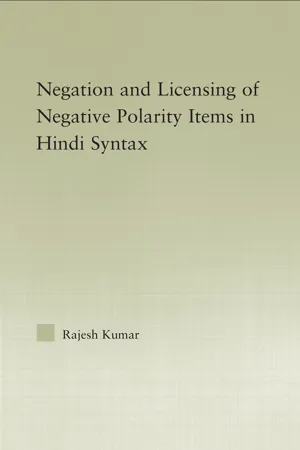![]()
Chapter One
Introduction
1. ABSTRACT
This study examines syntactic dependencies between negation markers and negative polarity items in Hindi. In order to do so, it first outlines a working clause structure of Hindi and locates negation markers within the clause structure. In Hindi clause structure, a negation marker heads its own maximal projection NegP, which is dominated by TP. In addition to locating the position of negation markers in the clause structure, this study outlines the distribution of negative polarity items in Hindi and the structural constraints on their licensing. I argue that the negative markers c-command the NPIs, and that this is a sufficient condition for the licensing of NPIs in Hindi. I also argue that NPIs are licensed overtly prior to scrambling. This work shows that the licensing of NPIs in Hindi does not involve any covert syntactic operations, such as LF movement or reconstruction. Finally, it shows that there are two different types of NPIs in Hindi, namely strong NPIs and weak NPIs. Strong NPIs require a clause mate c-commanding negative licensor, whereas weak NPIs are quantifiers and similar to the free choice ‘any’ in English, interpreted as NPIs in the presence of a c-commanding negative licensor. The data used in this study have been gathered from native speakers of Hindi.
There are two main aspects to the study of NPI licensing. The first aspect deals with how licensing principles are formulated and at which level of representation the licensing principles apply The second aspect of the study of NPI licensing deals with whether the nature of licensing principles is purely syntactic (Jackendoff 1969, Lasnik 1975, Laka 1994, and Progovac (1994)), and, purely semantic (Ladusaw 1979), or a combination of both syntax and semantics (Linebarger (1980), 1987). This study proposes a syntactic analysis of NPI licensing. The basic assumption in most of the studies on the licensing of NPIs (Lasnik 1972 and 1981, Laka 1989 and 1994, Mahajan 1990a, and Benmamoun 1997 and 2000) is that NPIs require a c-com-manding negative licensor. In Hindi, a head final language, in which negative licensors occur at the immediately preverbal position, NPIs appear to occur higher in the structure than negative licensors. Thus, the negative marker does not c-command the NPI, and subsequently it fails to license it, under the assumption that the negative element must c-command the NPI. The questions that arise from this are as follows: (1) What are negative polarity items in Hindi? (2) How is negation structurally represented in Hindi? And (3) How are NPIs licensed? This study provides answers to these questions.
2. ORGANIZATION OF CHAPTERS
This study is organized as follows. The first chapter introduces the problem, summarizes various proposals, and briefly presents a summary of research in the field of negation and NPI licensing in English, Hindi, and other languages.
The second chapter presents a detailed discussion of the clause structure of Hindi. A detailed study of Hindi clause structure helps to clarify the syntax of negation and the licensing of negative polarity items. In addition to discussing clause structure, this chapter focuses a great deal on the various characteristics of Hindi sentences. The first section of the second chapter presents a brief review of the typological features of Hindi, with particular reference to word order: the positioning of auxiliary verbs, ad-positions, complementizers, and modifiers. Then, it presents a detailed discussion of the various components of the Hindi sentence. It also discusses the structure of Hindi in the light of recent syntactic works and issues, particularly focusing on Chomsky (1989 and 1995) as discussed in Mahajan (1990a) and Kidwai (2002). Finally, I present a clause structure in this chapter that makes correct predictions with regard to the study of syntax of negation in Hindi. The proposed structure is not only a modification of existing proposals, but it is also consistent with the facts of Hindi, and dispenses with AgrP.
In Chapter Three I present a description of the distribution of the markers of negation in Hindi. I also elaborate on the different positions of negation in clause structure, focusing on negation in different tenses, and imperative sentences, and, finally, on the interaction of negation with light verbs. It is the interaction of light verbs and negative markers that solves the puzzle of the categorical status and location of negatives in the Hindi clause structure. The second issue that I discuss in this chapter is the question of sentential and constituent negation. I present evidence in support of the immediately preverbal negation marker as sentential negation, argue that sentential negation is located outside VP, and suggest that negation markers head their own maximal projection and are located in a position dominated by TP in the clause structure of Hindi.
In Chapter Four I present a detailed discussion of the distribution and description of NPIs. I suggest that there are two types of NPIs, namely, strong NPIs (those that strictly require a clause mate c-commanding negative licensor) and weak NPIs (the elements that can be interpreted as NPIs both in the presence of a c-commanding negative licensor, and are also allowed in the questions, conditionals, modals, and adversative predicates). Later, I discuss the available accounts (Jackendoff 1969, Lasnik 1975, Ladusaw 1979, Linebarger (1980), Progovac (1994), and Laka 1994) of the licensing of NPIs in other languages, and, while doing so, I show the inadequacies of such analyses for giving an account of NPIs in languages such as Hindi. I also discuss the problems with an existing analysis for the licensing of NPIs in Hindi (Mahajan 1990a). Finally, I propose my own analysis, showing that NPIs in different positions are licensed overtly prior to scrambling. I show that NPIs are all licensed overtly and that the licensing of NPIs does not involve any covert syntactic operation.
In Chapter Five I discuss the nature of the two types of NPIs in Hindi: strong NPIs and weak NPIs. Strong NPIs are real NPIs, while weak NPIs ...
